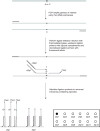PCR/LDR/universal array platforms for the diagnosis of infectious disease
- PMID: 20217576
- PMCID: PMC4381875
- DOI: 10.1007/978-1-60761-663-4_9
PCR/LDR/universal array platforms for the diagnosis of infectious disease
Abstract
Infectious diseases account for between 14 and 17 million deaths worldwide each year. Accurate and rapid diagnosis of bacterial, fungal, viral, and parasitic infections is therefore essential to reduce the morbidity and mortality associated with these diseases. Classical microbiological and serological methods have long served as the gold standard for diagnosis but are increasingly being replaced by molecular diagnostic methods that demonstrate increased sensitivity and specificity and provide an identification of the etiologic agent in a shorter period of time. PCR/LDR coupled with universal array detection provides a highly sensitive and specific platform for the detection and identification of bacterial and viral infections.
Figures



References
-
- Boissinot M, Bergeron MG. Toward rapid real-time molecular diagnostic to guide smart use of antimicrobials. Curr Opin Microbiol. 2002;5:478–482. - PubMed
-
- Muldrew KL. Molecular diagnos tics of infectious diseases. Curr Opin Pediatr. 2009;21:102–111. - PubMed
-
- Procop Gary W. Molecular diagnostics for the detection and characterization of microbial pathogens. Clin Infect Dis. 2007;45:S99–S111. - PubMed
-
- Barany F. The ligase chain reaction in a PCR world. PCR Methods Appl. 1991;1:5–16. - PubMed
Publication types
MeSH terms
Substances
Grants and funding
LinkOut - more resources
Full Text Sources
Medical

